7 Ways to Automate Your Work: Tips for Working Remotely During a Pandemic
If your team has never fully jumped into working remotely, the transition isn’t always easy. Running a business is difficult and time-consuming enough when you’re not facing a pandemic. It’s one thing to have remote work tools in your arsenal, but it’s another to make them really work for your team.

This post was originally published on the AppSumo Blog
If your team has never fully jumped into working remotely, the transition isn’t always easy. Running a business is difficult and time-consuming enough when you’re not facing a pandemic.
It’s one thing to have remote work tools in your arsenal, but it’s another to make them really work for your team. One of the most effective ways to work remotely is to automate your tasks, so you can manage the daily chaos, stay in sync with your team, and save time instead of wasting hours on manual work.
Configuring your lines of communication and effectively managing your data are the two most important elements to get started with remote work. But what if you could automate these processes and take your team to the next level?
Here are the top 7 remote work automations we love and use over at Stackby, a powerful tool to create, customize, and automate your team’s workflows. Don’t worry – they’re simple and actionable. You can use these methods to streamline your work processes and stay connected, regardless of where you are.
Work Automation Tips For Remote Teams During a Pandemic
1. Slack your Google Calendar Events and Manage Them in a Database
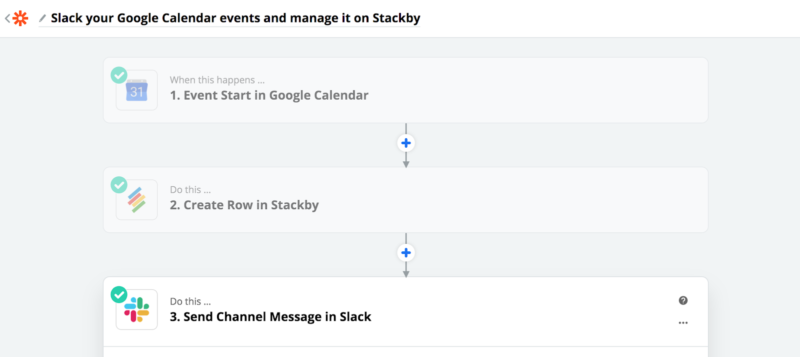
Required apps: Zapier, Google Calendar, Stackby, and Slack
A small automation can lead to big savings. It could be as easy as getting an alert when something changes or gets added.
One such automation is with a calendar. We all use calendars to manage our schedules and sync them with our teams to make the best use of our time.
But sometimes we’re so engrossed with our work that we overlook updating our calendars, scramble for meeting links, and miss important client meetings. (Yes, it’s happened before.)
A small automation could make all the difference in helping you stay on top of your events.
Slack your Google Calendar events, along with associated meeting links, as they approach. Then manage them in a database (like Stackby) to add notes and maintain history.
You can do this by creating a multi-zap workflow with Stackby and Zapier.
2. Collect Web Form Responses Directly in Your Database and Get Notified on Slack
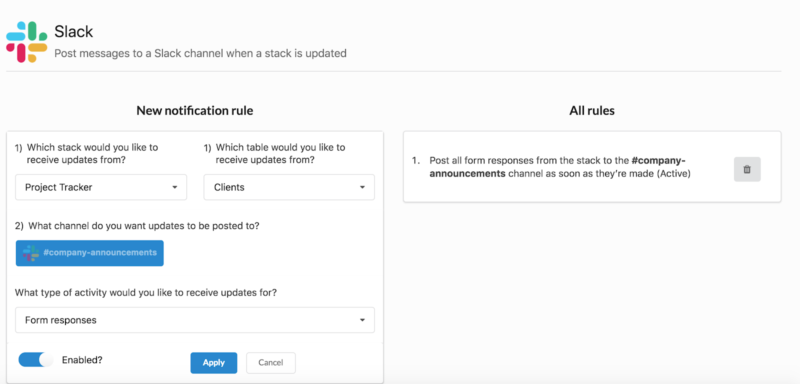
Required apps: Stackby and Slack
Whether you’re tracking your employee PTO, going through job applicants for recruiting, handling bug issue requests, or even collecting client surveys, you need an online web form.
Online web forms have become massively popular. With the advent of newer design tools like JotForm, Typeform, AidaForm and more, they’re increasingly used by all sorts of businesses day-to-day.
Stackby has a new form layout that allows you to build custom forms and bring your form responses directly to your table. Not only can you collect text responses, but you can also introduce attachments, list drop-downs, and reference lists from other tables.
Rather than passively build forms and collect responses, the trick is to manage them and take immediate action. Seeing the data alone isn’t enough for teams – you’ve got to communicate effectively and delegate accordingly. Luckily, you can automate this.
You can connect Stackby tables to notify any of your Slack channels of new form responses, so team members can stay on top of the work.
3. Notify Your Team of Due Dates and Set Up Auto-Reminders in Slack
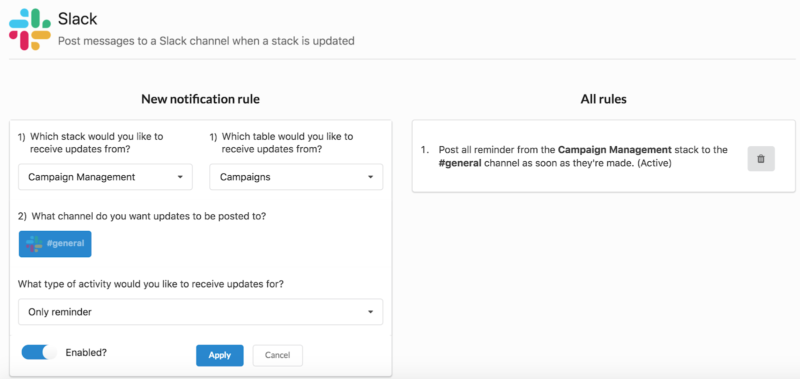
Required apps: Stackby and Slack
When it comes to tracking due dates and setting reminders, using automated tools can be a game-changer. It’s a simple process, but most of us don’t do it.
It’s time we use these basic automations religiously. These automations don’t have to come from a different app per se – you can opt for a platform where you’re already managing your data, projects and tasks.
In Stackby, you can set reminders on each row, and then notify yourself or your team in a Slack channel of your choice.
By doing this, you’ll create a streamlined process and make tasks, follow-ups, and deadlines actually count. No more manually following up with your team to get things done.
4. Create A Self-Updating Contact Book
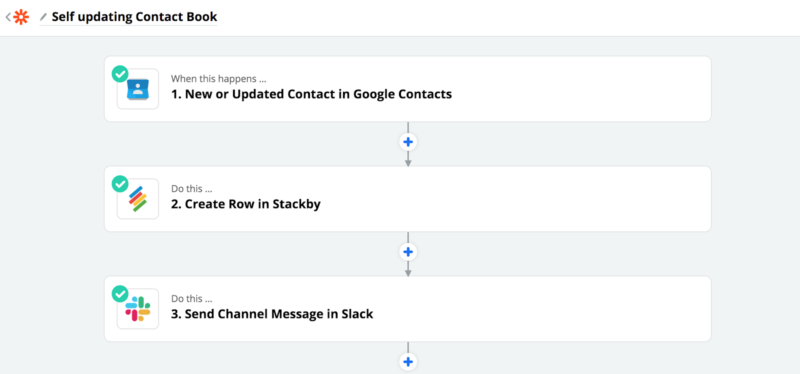
Required apps: Zapier, Stackby, and Slack
If you use Gmail as an email client, it’s likely that your contacts are stored in Google Contacts. It’s one of the best ways to manage all your email addresses and phone numbers.
Just one annoying issue: you’ve still got to click on each of your contacts manually to access their details. Currently, Google Contacts doesn’t have a user-friendly interface to fix this.
With this simple automation, you can create a magically self-updating contact book — just set it up once and you’re done.
Connect Google Contacts to Stackby via Zapier. As soon as a new contact is added or created in Google Contacts, it’ll get added to Stackby automatically. With a self-updating contact manager, you’ll be able to easily track leads, manage follow-ups and write notes, or integrate with your CRM.
5. Manage and Automate Your Daily Stand-Ups with Ease
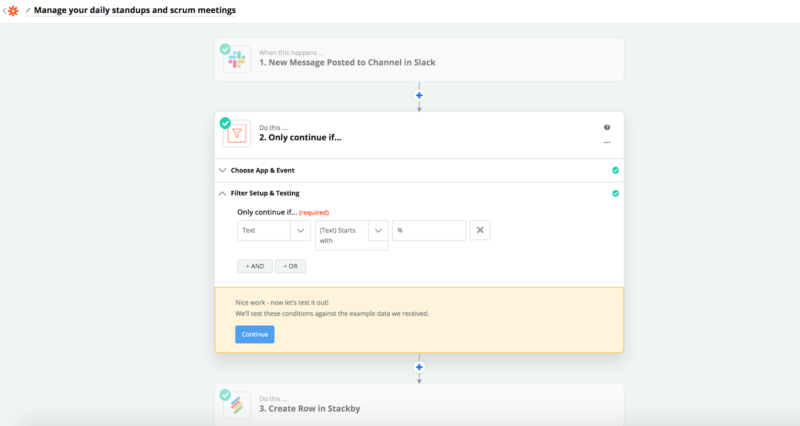
Required apps: Zapier, Stackby, and Slack
Communication and data management don’t always go hand-in-hand. We often communicate with our team and delegate tasks via messages. But when was the last time you logged these tasks and communications in a project management tool or a database?
It’s easy for messages to get lost in the noise. This, in turn, leads to scalability issues as your team and workload grows.
One of the best ways to handle this issue is to push a new task, stand up, or to-do message in a particular Slack channel to automatically create a new row in a database.
For example, with a multi-step Zap from Zapier, you can push a message from a Slack channel directly to a stack (database) in Stackby as a new row.
To better handle this process, we’ve recently discovered that you can add a filter in Zapier. We created a condition where only comments with a “%” before the comment would be added to the database. That way, we could block any irrelevant comments from the channel.
It worked like a charm. Now, our entire Product Team is able to manage and track our daily stand-ups, scrum notes, water cooler meetings, and module tasks super effectively.
6. Consolidate Your Marketing Campaign Analytics
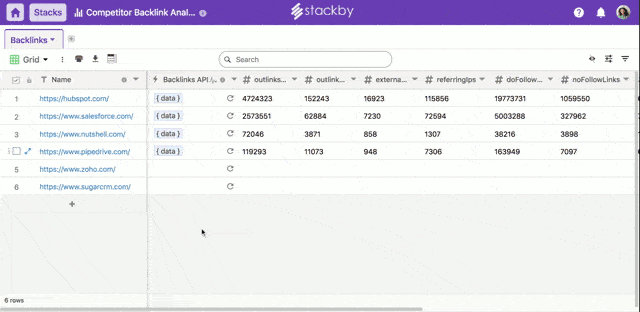
Required apps: Stackby and Supported Integrations
The average spreadsheet user spends 9 hours every week manually updating the same information. If you’re a marketer, you might be juggling multiple tools like spreadsheets, individual analytics dashboards, PM tools, and more. That’s too much time and effort when you could be automating.
With Stackby, you can plan and manage your campaigns easily, plus pull your campaign analytics and gather information in real-time. The best part? You can skip all the manual copy-pasting.
For example, you can track your competitor backlinks just by adding a domain URL and connecting your column to a SerpStat Backlinks API. Grab your live data in real-time.
You can connect tools like YouTube, Facebook Ads, MailChimp, Hunter.io, MatterMark, and more to pull information. This is perfect whether you’re building your lead lists; verifying emails; tracking video and social media metrics; performing keyword analyses; and more.
7. Automate and Track All Your News Stories in a Single Place
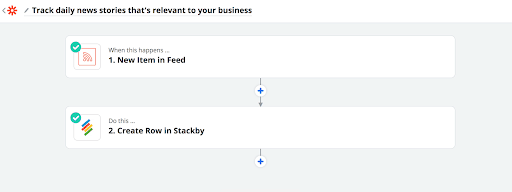
Required apps: Zapier, Stackby, and Slack
COVID-19 has taken the world by storm. We all want to stay updated on what’s going on. Regardless of where our teams are, this pandemic affects all of us. But we’re all in this together.
You can create a shared database to track all the latest news stories from the channel you follow and stay updated together as a team, regardless of your timezone.
Get started quickly by feeding a URL of your favorite news channel or a blog. As soon as a new story is published, you can see it in your stack (database) in Stackby. Rate the news story with a thumbs-up or a star, and level up your information gathering.
Conclusion

All these little automations will quickly add up in terms of saved time and productivity boosts. Even if you save just 15 minutes a day, the benefits will scale exponentially throughout the year and across team members. That means spending more time with the people who matter to you and on the things you love doing. A bit of extra effort now will go a long way for your future processes. Trust us – it’s worth it.
Start your remote work automation journey today!


![Best 14 HR Database Software for Recruitment Agency [Free+Paid] [2026]](/blog/content/images/size/w960/2024/04/stackby--hr-database-software-blog-post-5.3.jpg)
![A Simple Guide on Workflow Management Software [Updated 2026]](/blog/content/images/size/w960/2021/12/work-management-blog.png)
![Step by Step Guide on How to Build Forms in a Database [2026]](/blog/content/images/2022/03/form-database-blog.png)
